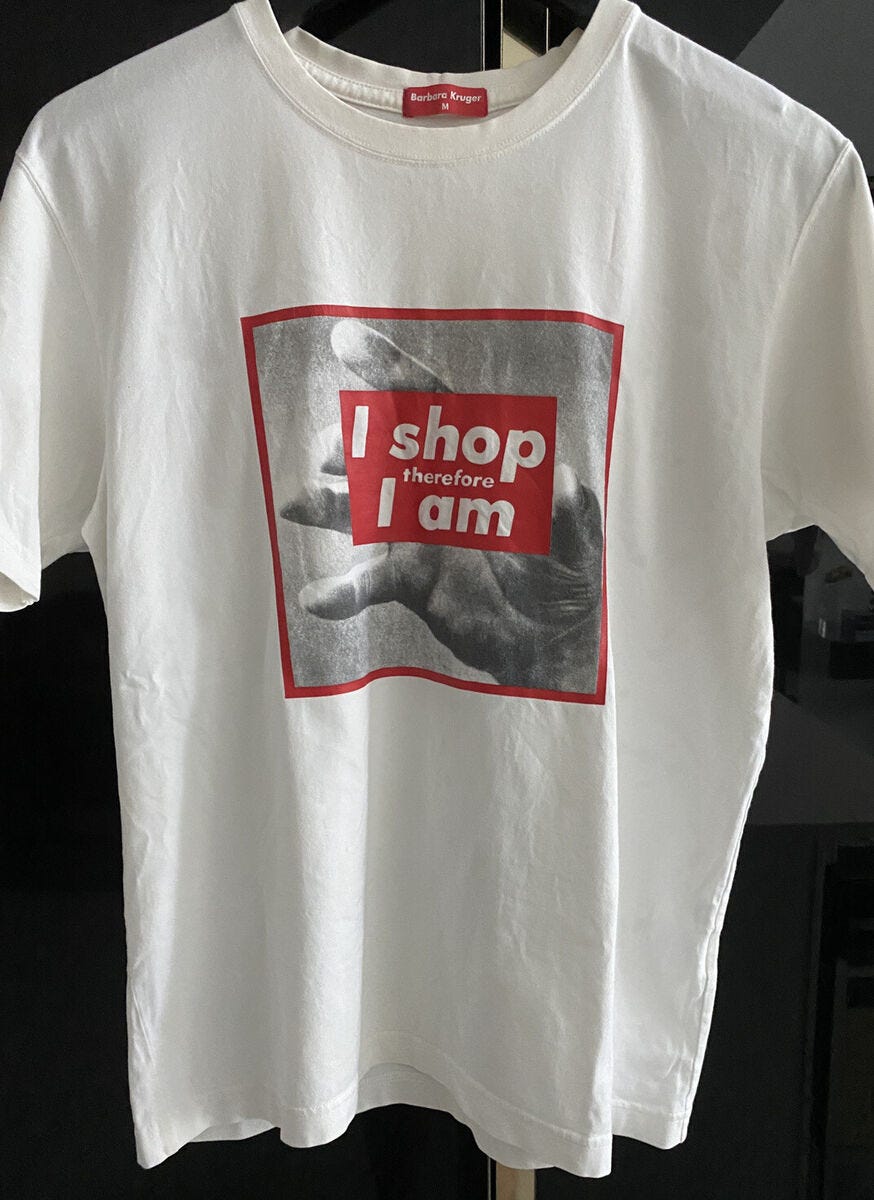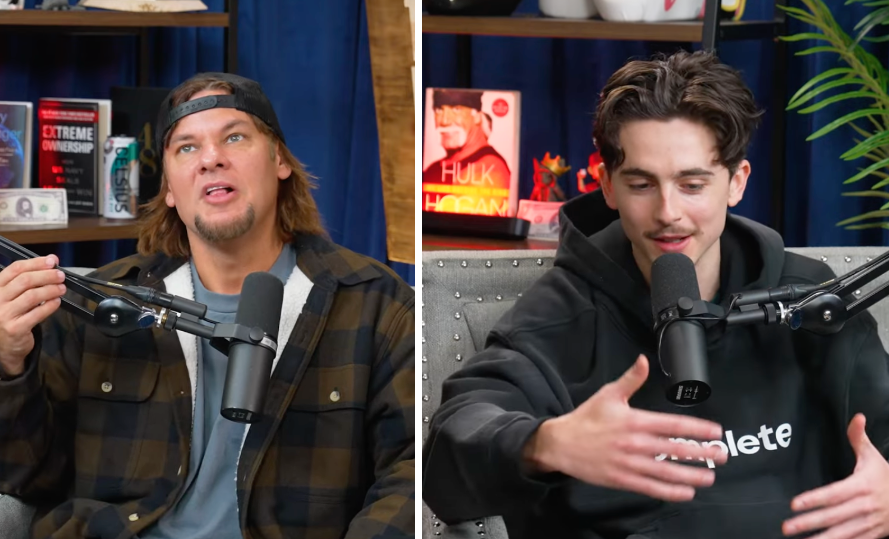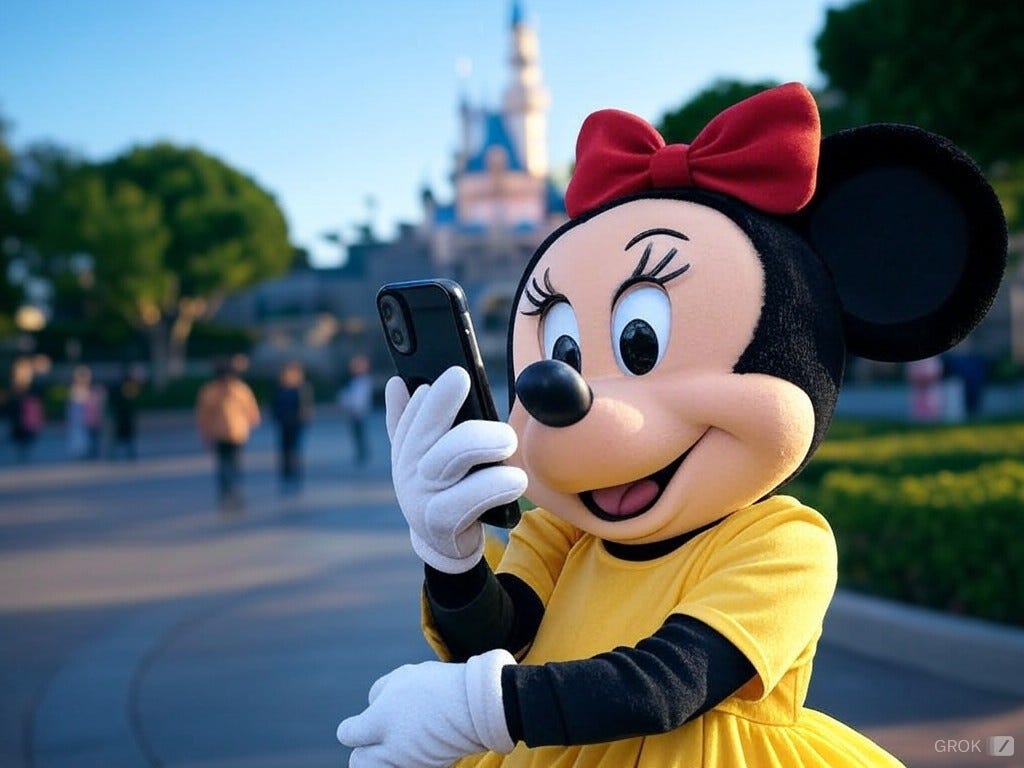The End of Artifice
Podcasting challenges late nite, lying in media, shopping as content, super consumers and Alex rediscovers America at Disney.
Hello all… Glad you are back.
Below are this week’s five topics, all discussed in more detail on your favorite People vs Algorithm’s podcast (out TOMORROW morning).
Also… this week the Anonymous Banker dropped by the newsletter. Scroll to the end to see thoughts on the next cycle.
Troy, Alex, Brian
One: Tim and Theo
Troy: The real Timothée Chalamet showed up for a 90-minute conversation with Theo Von this week to promote his new Bob Dylan biopic, A Complete Unknown. The pod hit almost 2 million views on YouTube in three days. In comparison, Chalamet’s seven-minute appearance on Colbert last Thursday has drawn less than 450,000 views. It’s a complicated comparison for many reasons, but directionally important, nonetheless. These new formats have reach and depth.
The Youtube podcast turned eratz-late-night performance represents our steady departure from the crusty formality of broadcast television. Here, Theo Von’s vulnerable, Southern charm meets an excitable Chalamet head on. We get much more from this raw, under-produced version of reality. For that 90 minutes, the notion of “celebrity” — rendering humans as two dimensional playthings — dissipates into a more revealing conversation from which the essence of a person can safely emerge. Both have become wildly popular public figures. Both revere celebs before them like Bob Dylan that found the courage to embrace a “do not give a fuck” indifference.
A discussion about celebrity and who each might play in a future movie brings up Jim Carrey and his 2017 New York Fashion Week Bazaar Icons red carpet appearance, an event dedicated to the worship of raw celebrity (disclosure: That was a Hearst event. I was there then). His surreal outbursts that day characterize the modern moment somehow: “I wanted to find the most meaningless thing that I could come to and join and here I am.”
Von, with signature mullet, backwards cap, Mack jacket, light blue T and Adidas brings a dude-from-highschool relatability. Chalamet is jittery and unguarded, fidgeting with his sneaker laces as real people do. Chalamet wants to reject celebrity, which is loveable and naive. The format does, however, represent him as the best approximation of a real life Pinocchio: “I am not a empty celebrity, I am a real honest-to-goodness person.”
Even the ad reads reflect a modern media reality far removed from broadcast’s anachronistic pharma-soaked present; BlueChews, Kraken, ZocDocs, BetterHelp, PrizePicks. You can draw the line through those.
Media never dies, it only morphs. The old way can only be understood as “compression” — the logical consequence of filtering ideas and people and stories through a tightly constrained broadcast feeding tube. What comes out feels like baby food. The late night talk format will surely be a casualty of media’s democratic revolution. Podcasts and their video offspring show where this stuff goes next.
Or as Puck’s inimitable Jon Kelly rightly said to me the other day: “The great arc of media bends toward authenticity.” That seems right, and from where I sit, welcome.
Note: For those even modestly interested in Dylan’s magic… I suggest you watch this 2004 60 Mintues interview with Ben Bradley. Or this amusing 1965 San Francisco press confernece.
Bradley: You use the world DESTINY over and over in the book. What does that mean to you?
Dylan: It's a feeling you have that you know something about yourself nobody else does. The picture you have in your mind of what you're about will come true. That's kind of a thing you kind of have to keep to your self because it's a fragile feeling and you put it out there somebody will kill it so it's best to keep that all inside.
Brian: Much to Alex’s chagrin, I still spend too much time on X. Chalamet’s alternative press tour has dominated, from his uncannily dead-on college football picks to telling Vonn his sister lives with friends in a forest. Like John said, authenticity is the coin of the realm now, and many of the contrived set pieces of late-night TV or the magazine puff piece just don’t work as well. What I wonder is if mainstream media can ever regain its position of power. This has gone from the erosion to showing signs of a full-blown collapse.
Alex: I can admit that I watch ZERO talk shows. Maybe the odd clip here and there but I find the format just unwatchable. I might watch a clip from a monologue if it gets shared but I’ll always skip the interviews. Interviews are much more interesting in longer formats where you get a better sense of the person. I think people have a sense of what feels genuine and the more we experience that (or a semblance of it) the more the canned laugh and prepared question feels uncanny.
Two: The uniques are in the mail
Brian: Ozy Media CEO Carlos Watson was sentenced to nearly 10 years in prison this week for conspiracy to commit securities and wire fraud. Ozy was an extreme case of that era’s fly-by-night digital media brands puffed up by finding ways to game traffic numbers and truly fake it til you make it. The problem comes when you apply that ethos to raising money. You can lie to advertisers, not to Goldman Sachs. That’s just how it works. Imagine if they’d start jailing every exec who used a “traffic assignment” loophole to puff up their ComScore numbers in the 2010s.
Troy: Everybody in media lies.
Three: Where next for shopping content?
Troy: Seems worthy of discussion. Everybody has a gift guide now including the AirBnB founder guy, Joe Gebbia, who sells portable houses (called Samara… seem cool btw). Google created a Holiday 100 this year to show off their shopping layer. It’s boring.
Good shopping content needs research, taste and quirk. Affiliate incentives turned most of it into industrial content garbage. It’s been a mainstay of lifestyle magazines forever. The ability to reliably pull money from here is the biggest revenue risk to lifestyle publishers in 2025.
Was wondering… What works for you guys? How do you think affiliate will change? Why does Wirecutter suck? Where does AI push the space?

Alex: AI. It’s relatively easy to capture the buzz of a product, who likes it, price range. ChatGPT can already create a good list of product within any number of criteria. The rest is just about following people you like and seeing what they recommend. I don’t know what an authority looks like in the future although I still think America’s Test Kitchen has a place. Cooking is a category where you can recommend absolute “top products”. Many other categories don’t work like that. I’m still waiting for someone to build a great furniture search engine that can find stuff based on my own criteria. Google is exceptionally bad at this. There are way too many specific criteria to say “best lounge chair” so furniture is bad for lists.
Brian: Not to be Captain Obvious, but isn’t it just trust? People trust other people, particularly those with unique taste or who are obsessives about particular topics. Trying to scale that with faceless institutional brands was always going to be hard. And then you mix in the normal perverse incentives of the internet. To me, there are a couple kinds of recommendations. One is the unexpected and delightful. And the other is the best vacuum if you own a shaggy dog. The latter is great for Wirecutter and maybe AI. But the former is about humans. The best recommendations are a reflection of a person. It’s very hard at this moment to do that as an institutional brand.
Four: Next gen super-consumers
Alex: Most kids are watching content that is packaging around products. Tweens are becoming a big market for skin care products. They grew up watching creators unbox toys, now they watch creators do their skin care routine, creating super consumers.
Troy: This week I watched Nvidia’s Jensen Huang pull the nifty new Jetson Orin Nano from the oven in his home kitchen. It’s a little $249 robot brain and you can buy it on Amazon. We all live in a content marketing world now.
Also Alex… see the vile Costco Boom Family phenom.
Brian: The only skincare product I had was Clearasil. Different era. No acne positivity.
Five: Alex goes to Disneyland, discovers indigenous media consumers
Alex: Ever watch the way people use social media? It’s psychotic. Going through feeds at diabolical speeds. Swapping apps. Spent a long time watching people use their phones in lines at Disneyland. It’s out of control. People listen to pods at 3x. Scroll through content in milliseconds. Watch two things at once. Play games with a YouTube video playing on the same screen
Troy: I wish people would slow down to appreciate the ads. Don’t waste time at Disneyland.
Unrelated… But as astonishing the speed of the modern phone scroller, AI researcher Ethan Mollick reflects on the recent few months in progress in the field. Example: Peer review missed a key calculation error in a consequential research paper, one with significant public health consequences. Mollick uploaded the PDF on his phone and asked the latest OpenAI model to find it. It did in minutes.
The video advancements with Google’s new VEO 2 are wild. Post is worth a look.
Brian: I believe we all are part of the Golden Generation that had analog and feral childhoods. I’m sure studies will show that a brain developed on digital media — having an iPad used to distract you as a toddler — are far different than ours. Who knows, maybe that kind of brain is better suited for the chaos of The Information Space. Personally, I miss reading books instead of scrolling.
ANONYMOUS BANKER
The Next Cycle
Predicting 2025 will be a robust year for deal-making is easy. Market participants’ confidence in the economy is growing, interest rates are coming down, inflation is slowing, and DOGE is prepared to reduce government regulation and waste; all positive signs. On top of these factors, fundamental market dynamics naturally bring buyers and sellers together: bankers need to eat, founders need cash, and private equity pros want their carry.
Here’s where it gets tricky: the current deal landscape won’t support robust valuations for all sellers. The market realities for this cycle are: fewer good buyers, AI’s impact on search, content creation, and monetization is impossible to quantify (w/ most predictions being negative), and current public market valuations for media companies are at historic lows.
So, how will deals happen in 2025? More structure. This means that for buyers and sellers to transact, expect to see buyers shifting some of the transaction risk to sellers with contingent payments and other mechanisms so that the full transaction value is only achieved if the acquired business meets prescribed performance or operating metrics in the future.
A recent example is Gen Digital’s acquisition of MoneyLion and the use of a CVR. CVR stands for contingent value right and allows the seller to get additional value based on future milestones. Outside of pharma and biotech, CVRs are used sparingly, but it’s use in this deal is a harbinger of what’s to come. In this transaction, valued at over $1 billion, 20% of the total value is contingent on Gen Digital’s share price performance in the future; effectively, the additional value is unlocked only if the share price trades above a certain level within two years. So if Gen Digital wins, so do MoneyLion’s shareholders.
Where do we go from here? Don’t expect bankers to have Christmas off. A significant number of companies are preparing to come to market in Q1; calls have already started with potential buyers to gauge interest, NDAs are being traded, and initial meetings are scheduled for January. I’ve heard of some eager sellers who are even using historical company presentations and data sites to try and beat others to market; where potential buyers are expected to digest stale numbers with the promise of getting updated information… “soon.”
Outside of traditional processes, large conglomerates still have many actionable non-core assets. These assets aren’t being sold in formal processes, but owners will share information with reputable buyers on an ad hoc basis. The goal is to do deals with buyers who provide a high certainty of closing and guarantee simplicity vs. achieving premium valuations.
Lastly, there are rumblings at some of the more prominent media names that they desire to transact their way out of disruption. Outside of the publicly announced splits and spin-offs (WBD and CMCSA), expect to see more media names combine, split, or show up in a different form by year-end 2025.
- Anonymous Banker
Troy: Related.. The Drugs Young Bankers Use to Get Through the Day—and Night, WSJ






